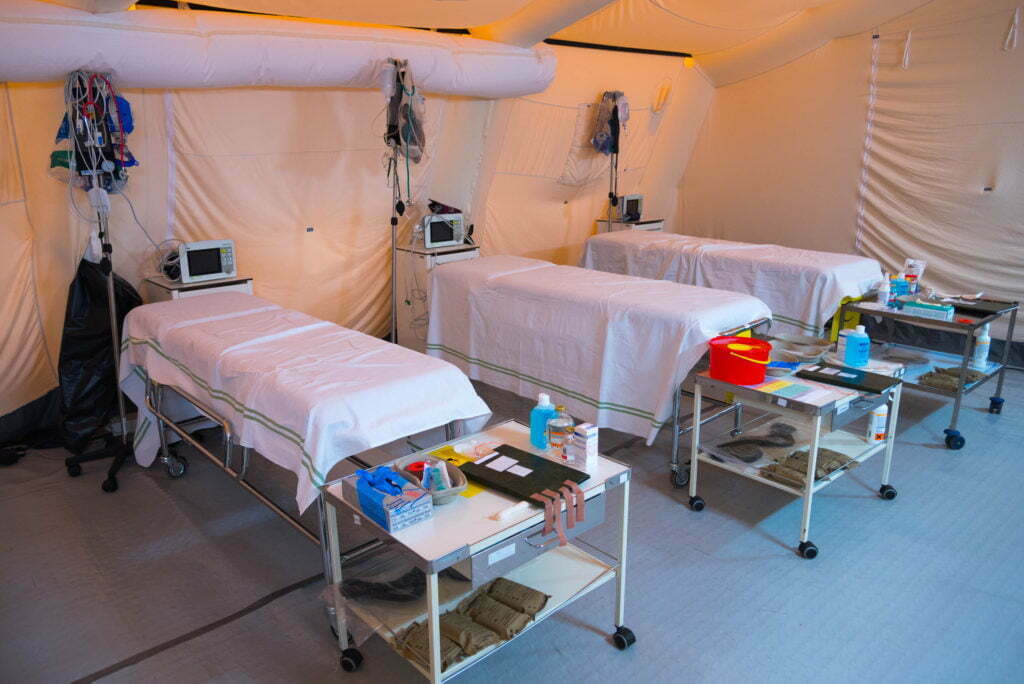Tips for Emergency Managers: Establishing Temporary Medical Facilities
Most small disasters don’t require temporary medical facilities to be established, but localities still must have a plan – the likelihood may be small, but the repercussions of not having a plan are monumental. Because each medical facility will have their own emergency operations plan (EOP), incident command will need to orchestrate and integrate all involved facilities to ensure they work effectively together.
Use these tips to develop a plan and coordinate available resources, staff and supplies during a disaster to setup one or multiple satellite medical facilities.
Coordinate with local medical facilities – hospitals, urgent care centers and doctor’s offices – early and often.
- Local medical facilities have their own emergency operations plans. Make sure you have an updated copy and know how their plans will work together with your agency’s emergency operations plans.
- Bring representatives from all medical facilities together with emergency management on a regular basis to maintain a relationship and review disaster operations plans. Invite them to your training sessions to integrate them into your disaster response team.
Have a designated point of contact for each medical facility.
- Make sure that each medical facility has pre-designated a staff member to take the stakeholder communications lead during an event.
- Know who this person is, reach out beforehand and have their contact information readily available during a natural disaster.
- Have at least one backup contact if the primary contact becomes unavailable during the event.
Air on the side of precaution.
- If you see an imminent threat to any major medical facility in your community, initiate the setup of a temporary medical facility as soon as possible.
- Even if you don’t end up using the facility, treat the process as an exercise and reflect on what worked and how to address what didn’t work after the emergency subsides.
Call on your state or local department of health for assistance and oversight.
- Work with your local health department during disaster planning to identify and implement mutual aid agreements for temporary medical facility locations. Having plans and aid agreements verified by the state can provide peace of mind to residents.
- If your locality doesn’t have a hospital or medical facility, work with your local or state health department to establish a plan for medical assistance during a natural disaster.
- If the local medical facilities and personnel available to your community become exhausted, call on your state department of health for additional resources. They can also provide additional general oversight during a disaster if your locality becomes overstretched.
Pre-identify temporary medical facility locations and implement mutual aid agreements.
- Medical operations can be established in community spaces like a schools, gymnasiums, churches or hotels. Identify locations before a disaster and have mutual aid agreements in place to quickly open facilities during an emergency.
- Assess the accessibility of the facility in all scenarios. For example, if in a flood-prone area, make sure it’s on high-ground; if prone to tornados, make sure it’s structurally sound.
- Ensure the facility has a generator to supply power during an outage, secured entrances and exits, wide hallways, temperature control and adequate lighting. Use the “Temporary Medical Treatment Station Selection Tool” from the Illinois Medical Emergency Response Team (IMERT) to evaluate temporary medical facility sites by specific criteria.
- Have multiple backup facility locations identified in case the primary temporary facility becomes impacted by the storm.
- Inspect facilities during planning to ensure they meet building and ADA requirements, in addition to requirements specific to medical facilities, like space and privacy.
Be prepared to establish medical facilities for a specified service.
- Have a plan for setting up nursing home care facilities, temporary morgues and immunization clinics, among others to meet your locality’s specific needs. During debris removal after a disaster, for example, there’s often a surge in need for tetanus vaccinations.
Have a plan for mobile medical facilities.
- Many localities, especially in rural areas, use grants to purchase mobile medical facilities that can provide services to remote or isolated communities. If you don’t have a mobile facility, have a plan to access a neighboring community’s mobile facility during a natural disaster.
Acquire additional resources from NGOs.
- Organizations like the Red Cross, United Way and local faith-based agencies can’t provide medical assistance, but they can provide additional supplies during a shortage.
Document, document, document.
- For reporting purposes, make sure to track number of patients treated, what for, their condition and how long they need to be treated.
- Don’t forget about privacy laws and requirements – HIPPA requirements still apply. Medical records should be individualized and organized to avoid any violations.
Don’t forget to notify the community and keep constant communication with stakeholders.
- Use all available forms of communication to push out information to the public on where, when and for how long medical facilities will be setup. Social media is your best bet, but make sure your 911 system is in full service so first responders can transport residents in need.
- Meet and coordinate with stakeholders before a disaster to develop a communications plan.
- Send frequent updates on how many patients are being treated, what they’re being treated for and resource shortages or needs to stakeholders throughout the disaster to maintain situational understanding.

